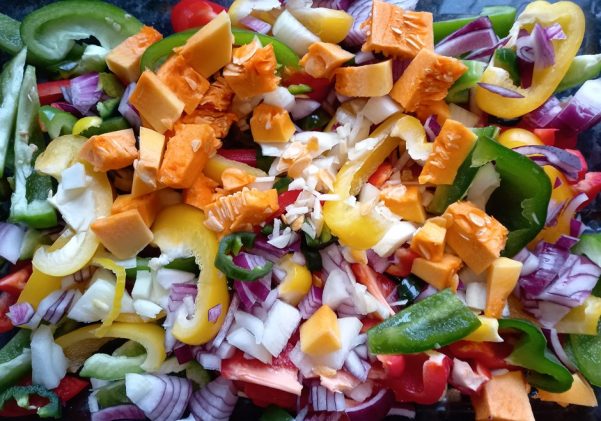Author Dr Paul Lunt (Director of the Low Carbon Devon Project)
At Christmas time, our attention is drawn towards food. My last harvest of the summer, pictured, consisted of brightly coloured peppers, chillies, tomatoes, onions, butternut squash and garlic. Like all growers, I spend the summers working with whatever nature throws my way in weather, pests and crop disease. This year in between the planting and replanting of lost crops, I also wrote an updated chapter on weather and climate for an established agricultural textbook on crop husbandry. This got me thinking about the resilient of the food bonanzas on our supermarket shelves. The awareness of people to challenges that farmers face in a changing climate. Also the potential opportunities that a changing climate presents for new crops in the UK.

The impacts of human caused climate change on crop production is one of our greatest challenges. As we reach the middle part of this century the world could face a ‘perfect storm’ of problems as food, energy and water shortages interact with climate change. The challenge globally is to increase food production by 10% per decade to feed a growing human population in a changing and increasingly unpredictable climate.
In recent decades we have observed a systematic geographic range shift, in the spatial pattern of crop planting in response to changing climate conditions. This shift shows a gradual northward movement of southern crops and locally an increase in the elevation of planting sites. All crop species have an optimum climate which meets the plants requirement for germination, growth and reproduction. In a crops optimum climate, losses will be minimized and yield maximised. Scientists in the UK, studying long-term data sets of biological response to seasonal changes in climate have shown that on average autumn is being delayed and spring events occurring earlier. In the last 50 years, this extension in the growing season equates to a 3 week increase, ~ two weeks in spring and one in autumn. Climate change is leading, on average, to fewer extremely cold days and nights.
In mid and high latitudes, such as the UK, suitability and productivity of crops are projected to increase and extend northwards, especially for cereals and cool-season vegetables, such as asparagus, beets and Brussels sprouts. A 2°C local warming in the mid-latitudes could increase wheat production by nearly 10% whereas at low latitudes the same amount of warming may decrease yields by nearly the same amount. Crops prevalent in southern Europe such as sunflower and soya beans could also become more viable in the UK. Here, yields could increase by as much as 30% by the 2050s.
Conversely, meteorological records suggest that heatwaves have become more frequent over the twenty-first century, with increased probability of a heatwave attributed to climate change. Europe experienced a particularly extreme climate event during summer 2018, with average temperatures 6 °C above normal and precipitation deficits of up to 300 mm, which in Northern and Eastern Europe resulted in multiple and simultaneous crop failures. In temperate oceanic climates, such as the UK, average cereal yield reductions to both droughts and heatwaves combined was 7%; with the largest losses for barley and no reduction for maize yield.
Increased rainfall can be beneficial in parts of the crop cycle where water is required for plant growth. However, intense rainfall can be problematic causing crop damage, soil erosion, soil water logging and flooding. Researchers found from 1964-2015 that floods had a significant effect on cereal yield at a regional level with barley showing a 3% decline in yield in north west Europe. However, at a European wide level this reduction in cereal grain yields was more than offset by a 5% increase in maize, due to wetter growing season, in southern Europe. Observed increases in maize yields are unlikely to carry on indefinitely as the impacts of climate change on water deficits become more pronounced in semi-arid regions of Europe.
Research can develop new crops and varieties via traditional plant breeding or by genetic modification to maintain yields in drier, warmer conditions. However, ultimately climate change will place greater pressure on wetter, cooler regions like the UK and northern Europe where in coming decades crop production is likely to continue to increase with temperature rises and longer growing seasons.
